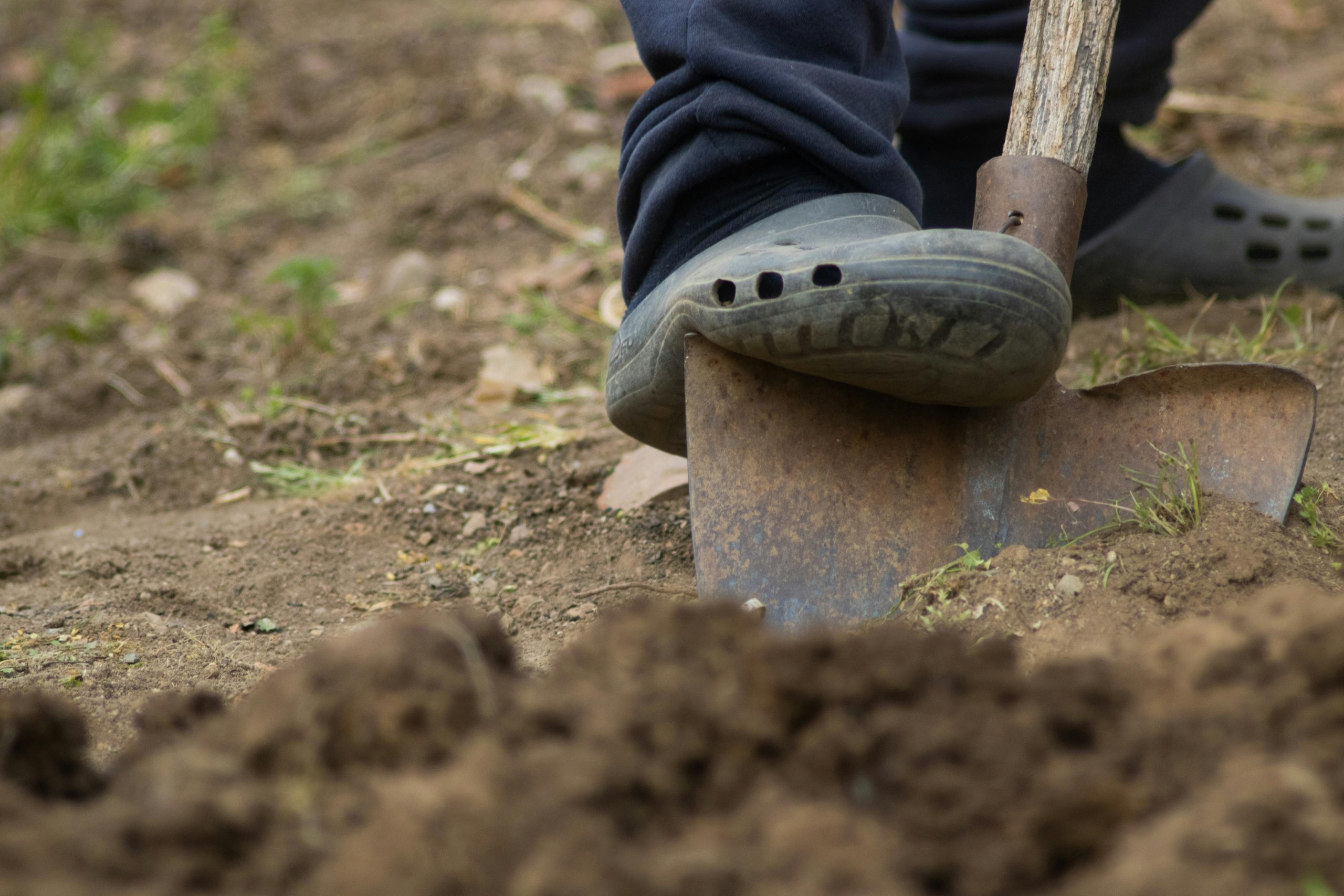- Plan carefully and account for slope challenges: Decide on a straight or curved layout and use step-ups or terracing for steeper slopes to reduce soil pressure.
- Prioritize proper drainage: Install gravel backfill, perforated pipes, and slope the wall away from structures to prevent water buildup.
- Prepare a solid, level base: Excavate trenches, compact the soil, and add gravel or wall rock to ensure stability for each section or step-up.
- Build step-by-step with careful block placement: Lay the first course level, fill hollow cores with rock, backfill and compact soil, and repeat for each step-up.
- Secure top rows and reinforce taller walls: Use concrete adhesive and consider geogrid for walls over 3 feet for long-term stability.
- Maintain the wall regularly: Inspect for cracks, leaning, or settling; clear debris; refill soil or gravel; and keep drainage systems functional.
Building a retaining wall on a slope isn’t just about stacking blocks—it’s about managing soil, water, and pressure while making your landscape functional and visually appealing. A well-constructed wall can prevent erosion, create usable space, and add value to your property. This guide walks you through building a long-lasting retaining wall on a slope, including step-up techniques for multi-level designs.
Why Build a Retaining Wall on a Slope?
Retaining walls are especially important for sloped landscapes:
- Prevent soil erosion: Stops water runoff from washing away soil.
- Create flat spaces: Makes room for patios, garden beds, or walkways.
- Improve slope stability: Reduces the risk of soil shifting or landslides.
- Enhance landscaping: Adds structure and visual appeal to your yard.
Understanding the purpose of your wall will guide material choices, drainage planning, and overall design.
Planning Your Sloped Retaining Wall
Before starting, it’s important to understand how to build a retaining wall properly, especially on a slope, to ensure durability and safety.
Decide on the Layout
Before digging, decide whether your wall will follow a straight line or incorporate curves. Stepped walls are ideal for steeper slopes, as they break the vertical rise into manageable levels, reducing soil pressure on each section.
Account for Drainage
Water pressure is the main threat to any retaining wall. Ensure proper drainage by:
- Including gravel backfill behind the wall.
- Installing perforated drainpipes at the lowest points.
- Sloping the wall slightly away from nearby structures to divert water.
Placement Relative to Other Features
Position the wall so it integrates with patios, walkways, or garden beds. Keep the top lower than nearby building foundations to avoid water pooling against your home.
Calculating Materials and Tools
Tools You’ll Need
- Shovel and spade
- Level (longer levels work best on slopes)
- Tape measure
- Rubber mallet
- Wheelbarrow
- String line and stakes
- Plate compactor
- Trowel or masonry tools
Materials
- Retaining wall blocks or concrete units
- Gravel or crushed stone for base and backfill
- Landscape fabric
- Concrete adhesive for top rows
- Sand (optional, depending on block type)
- Drainpipe (for proper water flow)
Accurate calculations prevent interruptions during construction and ensure the wall remains stable.
Preparing the Ground on a Slope

Digging the Trench
For each section or step-up of your wall:
- Excavate a trench at the lowest point. The trench should be wide enough to support the base and deep enough to include base material plus the buried portion of the first block.
- For taller sections, calculate extra depth: for example, a 2.5-foot wall may require 8–9 inches of total trench depth.
Compacting the Base
- Use a mechanical plate compactor to compress the soil at least twice.
- Add a layer of wall rock or gravel (around 6 inches) and compact it thoroughly.
- Install drainage pipes at the lowest points to prevent water pressure buildup.
Step-Up Preparation
- Each successive step-up requires repeating trench excavation and compaction for proper stability.
- Ensuring each step’s base is level and compacted is critical for preventing erosion and wall failure.
Installing the Blocks
Laying the First Course
- Place the first row of blocks in the prepared trench, making sure they are level.
- Verify alignment frequently using a long level or string line.
Filling and Backfilling
- Fill the hollow cores of the blocks and the area behind them with wall rock to promote drainage and stability.
- Backfill with soil, compacting from the back outward to avoid gaps or settling.
Building Subsequent Step-Ups
- Excavate and compact the trench for each next step.
- Repeat block placement, core filling, and backfilling until the wall reaches the desired height.
- Ensure that each block is buried appropriately to maintain the correct base depth and prevent shifting.
Securing the Top Rows
- Apply concrete adhesive to the top two rows to lock them in place.
- Ensure these blocks are level and firmly seated for a polished, durable finish.
Step-Up Design Considerations
When building on steeper slopes, step-ups or terracing is recommended:
- Shorter walls reduce pressure: Multiple levels are safer than one tall wall.
- Functional flat areas: Each step can create a planting bed or seating area.
- Improved drainage: Water moves between steps, reducing the chance of soil saturation and pressure buildup.
Properly designed step-ups make your retaining wall both functional and attractive.
How to Build a Retaining Wall on a Slope That Lasts
- Always start with a solid, level, and compacted base.
- Stagger joints between blocks to evenly distribute weight.
- Maintain consistent drainage behind each wall section.
- Consider reinforcement such as geogrid for walls taller than 3 feet.
- Periodically check the alignment during and after construction.
Common Mistakes to Avoid
- Skipping base preparation or improper soil compaction.
- Ignoring drainage needs, which can lead to leaning or failure.
- Uneven or misaligned blocks that compromise stability.
- Using unsuitable materials for the height or slope of the wall.
- Attempting a single continuous wall on steep slopes without terracing.
Maintenance Tips for Slope Retaining Walls
- Inspect for leaning, cracks, or loose blocks regularly.
- Clear debris and vegetation to maintain proper drainage.
- Refill soil or gravel where settling occurs.
- Replace damaged blocks immediately.
- Keep drainage systems free of clogs to prevent water pressure.
- Seasonal checks, particularly after heavy rains or freezing temperatures, help catch early issues.
Enhancing Your Retaining Wall
- Add capstones or decorative blocks for a refined finish.
- Plant low-maintenance shrubs or ground cover for erosion control.
- Mulch or gravel at the base can enhance aesthetics and reduce soil movement.
- Incorporate lighting along terraces or steps for safety and visual impact.
Final Thoughts
Building a retaining wall on a slope that lasts requires careful planning, proper materials, and attention to detail. By preparing a stable base, ensuring proper drainage, and incorporating step-ups where necessary, you can create a wall that stabilizes your slope, maximizes usable space, and adds long-term beauty to your landscape. Regular maintenance and smart design choices will help your wall withstand soil pressure, water, and weather for years to come.
